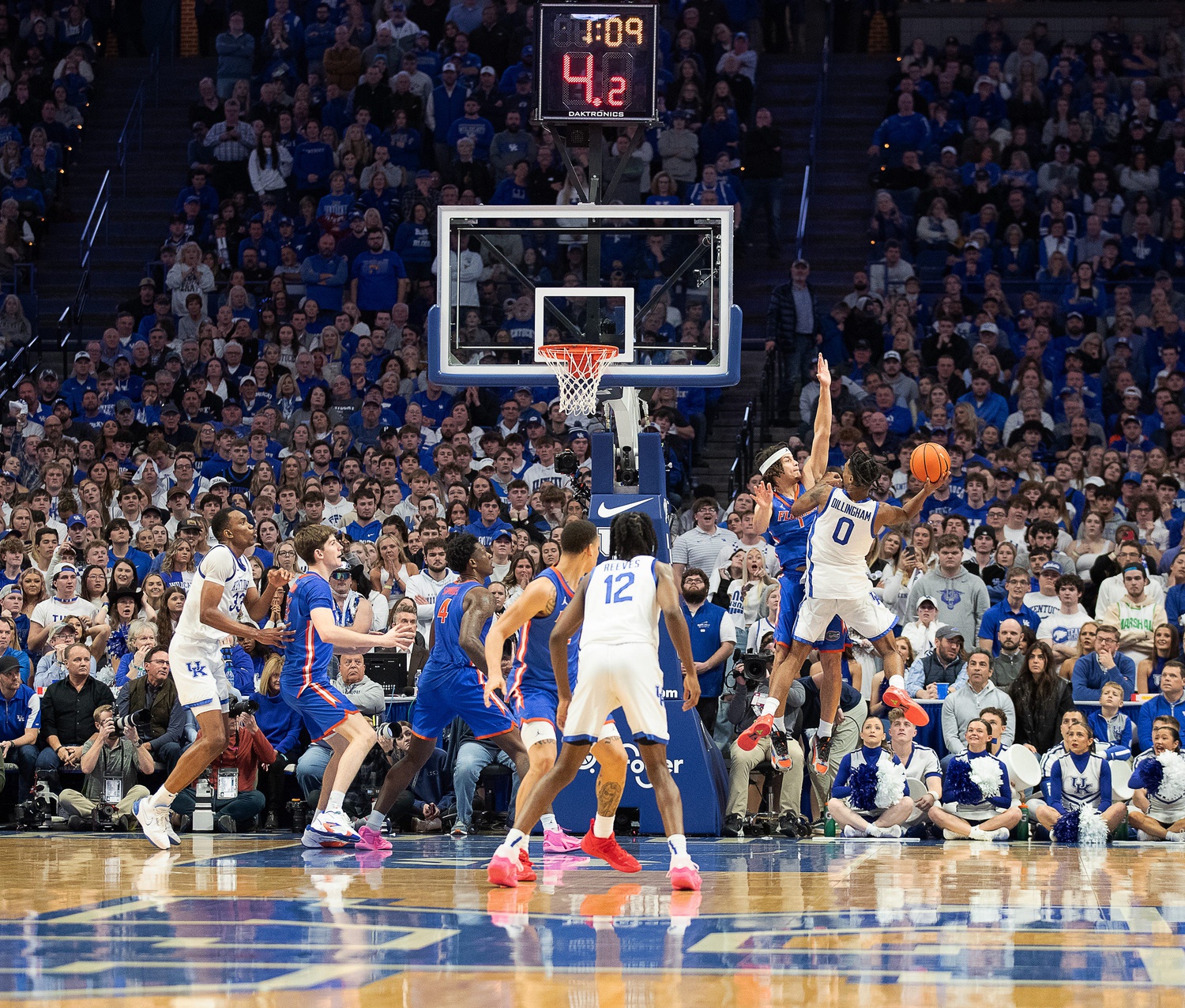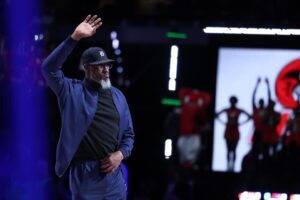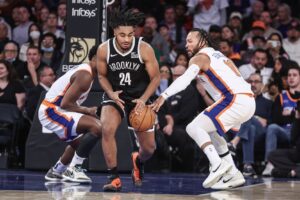This year’s NBA Draft class has been constantly criticized largely for not having a clear-cut star or top player. However, every draft class has stars and this year will be no different one or several of these players will eventually develop into stars. In a draft class that is filled with uncertainty could we all be overlooking a future star? In my eyes, Rob Dillingham checks the most boxes and has the most star potential in the draft. Let’s dive into Dillingham’s game and star upside.
Meet The Best Player In The NBA Draft
Rob Dillingham: A Prototypical Star Guard
When analyzing the prototype of NBA stars elite shot creation and scoring abilities top the list. There is no better shot creator and scorer in this draft than Dillingham. He is a proven three-level scorer averaging 15.2 points in his lone season at Kentucky. Dillingham’s elite combination of downhill speed, athleticism, handles, shooting, and finishing make him the complete package as a creator.
Dillingham shot 54.8 percent at the rim and 44.4 percent from three on four attempts per game. Additionally, Dillingham is a high-level passer who averaged 3.9 assists with an assist percentage of 29.7 he can operate out of the pick-and-roll or kick out to teammates while driving to the rim with pinpoint accuracy. Crucially, Dillingham is an incredible threat as both a creator and playmaker which is the needed skill set for elite guards in the NBA. Most NBA stars create shots for themselves and others at a high level Dillingham fits that description perfectly. Dillingham had an absurd 30.3 usage rate making him an ideal lead creator and offensive engine in the NBA. Ultimately, this skill set gives Dillingham extreme offensive potential.
Furthermore, Kentucky guards have a remarkable track record in the NBA and seem to produce stars each year. Kentucky has a total of 28 NBA players and an impressive eight of these have been All-Stars. This season eight former Kentucky guards averaged 17 or more points including the MVP runner-up Shai Gilgeous Alexander. Dillingham’s smaller build yet elite speed and overall scoring are very similar to Tyrese Maxey. The biggest knock on Dillingham is his size and subsequent defensive issues. Dillingham, listed at six-foot-one and 165 pounds, will likely have to bulk up some to deal with the increased physicality of the NBA. Similarly, he wasn’t a great defender at Kentucky.
Draft Range
Small guards are always targeted defensively in the NBA and Dillingham will have to improve his effort to avoid being a defensive liability. However, there’s no denying Dillingham’s offensive upside. In a draft class that is said to have no true star, Dillingham’s abilities as a creator and playmaker give the best chance. A few teams that could most benefit from Dillingham’s skill set are the Spurs, Jazz, and Wizards. Notably, despite the offensive upside Dillingham’s has slightly fallen on draft big boards. ESPN ranks Dillingham seventh, TheRinger ranks him 10th and CBS ranks him 13th. Now let’s compare Dillingham to some names consistently ranked above him.
Alex Sarr
Alex Sarr is the most likely No.1 overall pick. The versatile seven-footer offers incredible defensive potential as a rim protector who can guard several positions. Sarr’s defense makes him one of the safer prospects. However, his offensive game is very raw. Despite being an athletic finisher Sarr shoots plenty of jumpers at an inefficient clip. Furthermore, Sarr was inconsistent as an interior threat in the NBL. Sarr is somewhat of a project on offense and doesn’t have the upside of a creator like Dillingham. As a result, there’s a clearer path for Dillingham to become a star despite the stability Sarr’s defense gives him.
Zaccharie Risacher
Zaccharie Risacher is another player in the mix for this year’s top pick. Risacher is a versatile six-foot-nine wing with a knack for shooting. He is notably a career 40 percent three-point shooter. Additionally, his length and size give him plenty of defensive upside. However, Risacher’s lack of self-creation and ball-handling skills severely limits his star upside. He is also a below-average athlete posting a 31-inch vertical which further limits his upside. It’s very likely that Risacher has a long career as a high-level complementary player. Although it’s quite unlikely Risacher will be a true star and he projects to have a Michael Porter level role.
Stephon Castle
Stephon Castle is an elite defender and connective playmaker with great positional size at six-foot-six. He has the ideal combination of upside and win-now impact. Furthermore, Castle is a proven winner; he was an integral part of UConn’s back-to-back championship team as a freshman. However, Castle’s jump shot is a massive concern, shooting just 25 percent from beyond the arc at UConn. Time and time again we’ve seen the importance of outside shooting for guards. If Castle can’t figure out his jumper the chances of him being a star are close to none. Regardless there’s a strong chance Castle has a long career and he still has some of the higher star upside. Ultimately though Dillingham’s elite creation and shooting abilities give him the edge.
Donovan Clingan
Donovan Clingan offers similar defensive and rim protection abilities to Sarr. Notably, the seven-foot-two Clingan averaged 2.5 blocks in his sophomore year at UConn. However, Clingan is significantly less mobile and versatile than Sarr. In the NBA these skills are increasingly important defensively. Clingan is also a high-level rebounder averaging seven per game and an interior scorer averaging 13 points per game. His offensive game offers potential as an inside scorer and lob threat. While this sounds like a very nice prospect with a quality NBA skillset Clingan doesn’t scream star upside.
Reed Sheppard
Dillingham’s backcourt mate Reed Sheppard is a well-rounded guard with plenty of upside. Sheppard averaged 12.5 points, 4.5 rebounds, and 4.1 assists on .536/.521/.831 shooting splits. His 2.5 steals and .7 blocks per game speak to his defensive abilities. Sheppard’s knockdown shooting and defensive prowess make him one of the picks in this draft class. However, his self-creation and ball handling aren’t at a star level right now. Sheppard had just an 18 percent usage rate compared to Dillingham’s 30. Furthermore, Sheppard is more of a connective playmaker while Dillingham is more of a lead guard. Sheppard projects to be a high-valued complementary guard who can provide a little bit of everything. It’s possible Sheppard can develop into the star of this draft; maybe both he and Dillingham will both blossom into stars. However, Dillingham’s advanced shot creation and playmaking abilities give him the best chance.
Matas Buzelis
Matas Buzelis could have been the No.1 pick if it weren’t for a bad shooting season in the G-League. He shot just 27 percent from three and 67 percent from the line. Buzelis was a high-quality shooter in high school and if that shot returns he could be the star of this draft. As a six-foot-ten forward Buzelis offers plenty of versatility as an elite finisher, rebounder, and secondary playmaker. However, despite the intrigue of Buzelis as a do-it-all forward the prototype of Dillingham-like players sees more success. If Buzelis doesn’t develop a jumper he will be left open and exposed in playoff settings.
Franz Wagner and Josh Giddey are similar players who dealt with this treatment in the playoffs. While smaller guards will always be targeted, this year’s playoffs showed the success of Jalen Brunson, Tyrese Maxey, and Darius Garland. If Dillingham translates as creator and playmaker that’s the type of player we’ll be looking at. Even if Dillingham doesn’t reach that level a Malik Monk or Immanuel Quickley-type microwave scorer is realistic and this skill set would keep him on the court during playoff games. Similarly, Dillingham’s scoring gives him a high floor whereas Buzelis’ doesn’t have a clear elite strength. None of this should be a knock on Buzelis in fact for upside in this draft I believe he is within the top three as a big forward with an incredibly well-rounded skill set. However, his jump shot will have to return to his high school level for this potential to be fulfilled.
The Last Word
Ultimately, the draft is unpredictable, and trying to predict a star is harder than ever in this draft class. At the same time, the unpredictability and lack of a clear star make this draft class so intriguing despite all the negative coverage around it. Based on prototypes of NBA stars and the importance of self-creation abilities Dillingham has the most star upside. Dillingham won’t be taken first overall and could even fall to the late lottery. Nevertheless, his offensive upside as a creator and playmaker can not be ignored. There are a plethora of signs that point to Dillingham developing into a star and this upside doesn’t exist among many of the elite players in the draft. As a result, I believe Dillingham is this draft’s best player.






